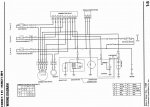You are using an out of date browser. It may not display this or other websites correctly.
You should upgrade or use an alternative browser.
You should upgrade or use an alternative browser.
H3011H only runs when starter is engaged
- Thread starter fordperf
- Start date
More options
Export threadAgreed, I will test as many of the switches as I can. My Fluke has a tone for continuity thankfullyNumber 1 rule
Check everything assume nothing.
All of the switches appear to have only one pair of contacts.
If that is the case they will be simple on off switches so you can connect a meter to the terminals then work the switch plunger.
Every time you depress the plunger the meter should change.
Check the seat switch by getting on ^ off the seat , check the brake by turning it on & off, same thing with the PTO switch.
Do it a couple of dozen times, If it fails to work on any single occasion then the switch is worn out,
If all f the switches are working properly then all that leaves is a broken wire or a broken relay or ignition switch.
I can not be any more specific than this because we did not get that mower down here so I can not get a wiring diagram for it.
Usually the switches are a ground circuit but when a master relay module is used then can be either a power or a ground circuit.
bertsmobile1
Lawn Royalty
- Joined
- Nov 29, 2014
- Threads
- 65
- Messages
- 24,995
OK,
Now we have a wiring schematic we can do some thing
All of the safety switched are ground switches.
So in the run position seat occupied, brake on , PTO off , in Neutral ,you should see these measurements at the Relay plug
G/R = Ground
W / Bl = Ground
G / Bu = open
Bl / R = open
Bl / Y = battery voltage
Bl / W = open ( should show battery voltage when the key is in Start position )
G / Y = Ground
G / Bl = Ground
Bl / Bu = open ( should show battery voltage when the key is in Start position )
BL = Ground
If not make some jumpers and jump the seat PTO & neutral switches
If you don't get the right reading with the switches jumped then you have a wiring fault, most likely a chaffed wire making a ground contact or the relay is broken
Put your meter between the Bl / R wire and ground.
IT should read ground when the key is off
IT should read open in the start & run position ( jumped as per above. )
Now we have a wiring schematic we can do some thing
All of the safety switched are ground switches.
So in the run position seat occupied, brake on , PTO off , in Neutral ,you should see these measurements at the Relay plug
G/R = Ground
W / Bl = Ground
G / Bu = open
Bl / R = open
Bl / Y = battery voltage
Bl / W = open ( should show battery voltage when the key is in Start position )
G / Y = Ground
G / Bl = Ground
Bl / Bu = open ( should show battery voltage when the key is in Start position )
BL = Ground
If not make some jumpers and jump the seat PTO & neutral switches
If you don't get the right reading with the switches jumped then you have a wiring fault, most likely a chaffed wire making a ground contact or the relay is broken
Put your meter between the Bl / R wire and ground.
IT should read ground when the key is off
IT should read open in the start & run position ( jumped as per above. )
Ok I assume starting the motor takes more than 5 amps which would blow the fuse, but then why have a 5 amp fuse at all off the battery? What else is the battery doing besides starting the engine and there is a bypass around the fuse, so then why have a fuse..That is your main starter power cable. It should be 6 ga wire; although, some oem uses a 8 ga wire.
AVB
Well-Known Member
- Joined
- Dec 13, 2019
- Threads
- 0
- Messages
- 200
First it is power for the relay(s) and PTO clutch when the engine is not running (the run and start position). Second it is the alternator (here called the charge coil) voltage regulator positiive return path to recharge the battery.
There is no bypass of the fuse.
There is no bypass of the fuse.
This just hit me as I was walking back to my office, it provides limited 12v power for the buzzer and continuity circuits and to move the relays. I did not know about the return path thank you.First it is power for the relay(s) and PTO clutch when the engine is not running (the run and start position). Second it is the alternator (here called the charge coil) voltage regulator positiive return path to recharge the battery.
There is no bypass of the fuse.
So the magneto spinning on the motor creates an ac current, which the rectifier converts back to dc to be used to run things like the buzzer and circuit continuity and charge the battery back in through the 5a fuse once the engine is running

